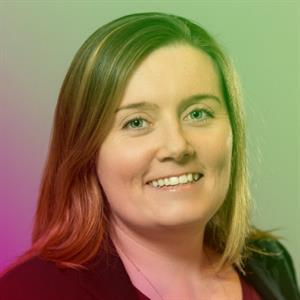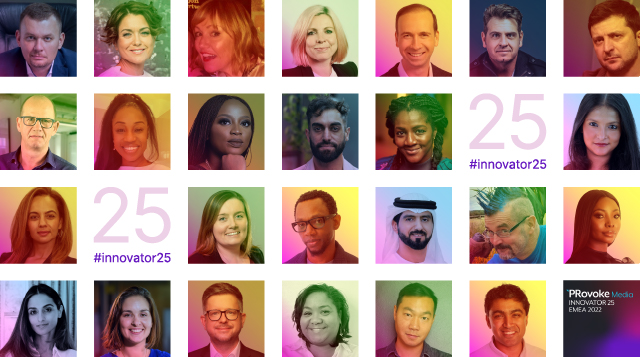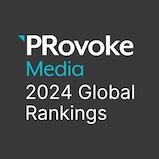
Julie O’Donnell
EVP, Global Head of Digital
Evoke Kyne
Waterford
“Too often people are distracted by shiny things – using new technology, new channels or new communication techniques as an innovation tick-the-box. That’s smoke and mirrors and not true innovation that has a lasting impact."
A purpose-driven digital strategist, Julie O’Donnell uses the power of her craft to educate, inspire and change behaviours, helping break down barriers to health. Since joining Evoke Kyne in 2018, she’s helped embed digital into the fabric of all the $40m agency’s client programmes, along with building a 35+ global digital team from the ground up to work across all accounts including big-name pharma like Janssen and AstraZeneca. For the latter, she and her team led the development of a major campaign around COPD which will be rolled out on a large scale this year.
A founder of two health tech start-ups, O’Donnell is a sought-after specialist and thought leader in the industry and acts as a trusted voice within the industry on topics like care provider comms, crisis planning and corporate digital change management. She also uses her significant influence and personal experience to help foster empathy and understanding for LGBTQI professionals within pharma and biotech.
How do you define innovation?
Innovation is all about new ways of doing things and this can mean new approaches, new services or new products. Ultimately true innovation has to be rooted in deep audience insights to understand their pains, needs and opportunities within the context of the broader organisational, commercial or healthcare landscape. Too often people are distracted by shiny things – using new technology, new channels or new communication techniques as an innovation tick-the-box. That’s smoke and mirrors and not true innovation that has a lasting impact in terms of changing mindset, behaviours or really redefining how a problem is addressed. Unfortunately, what most organisations need is purposeful, incremental innovation which often means doing the basics well, iterating, testing and learning and evolving from there, but that takes patience and a long-term strategy and is a lot less sexy to talk about!
What is the most innovative PR or marketing initiative you've seen over the past 12 months?
The Ford ‘Very Gay Raptor’ campaign really caught my eye. Through smart social listening they were able to take some negative social posts from people who didn’t like the car’s blue colour and described it as ‘very gay’ and transform that into a PR campaign that grabbed attention. Other teams might have just ignored those posts, but they were progressive in their thinking and used them as a platform against discriminatory language and homophobia. Considering this was likely to alienate some of their traditional US customer base, this was a bold move. Spotify’s ‘Wrapped’ in December was perhaps their best yet. They’ve been doing this since 2016 and have been consistently creative in terms of how they harness user data to engage diverse, global audiences. Creating fun, hyper- personalised content for each user but also content that’s so inherently sharable it starts conversations and sparks a viral moment annually.
In your opinion, which brands and/or agencies are most innovative in their approach to PR and marketing?
Dove from Unilever has consistently come up with smart ways to engage audiences across channels. They’ve gone from their Campaign from Real Beauty and iterated constantly while keeping a very ‘Dove’ feel. I think right now there are a lot of pharma companies deep in the trenches of organisational change and capability building, but in the coming year or two we will start to see the payoff for their efforts with more pharma companies being recognised for their innovation.
Describe a moment in your career that you would consider to be innovative.
One that sticks out for me was from the early years of my career – about 10/12 years ago. I was working with a pharmaceutical company and helping them to enhance their digital strategy. I pushed them out of their comfort zone by going deep on healthcare professional and patient interviews to inform the approach which wasn’t something they’d done previously. I still remember the moment on a call with a specialist nurse where she described what she and many colleagues did to address patient concerns. That moment was a true lightbulb moment and became the basis of the company’s first smartphone app which brought something that the nurses had been doing ad hoc into a structured support tool at scale. It had broad endorsement and engagement. I was operating instinctively but of course that insight-driven approach and solution co-creation is something I’ve tried to consistently integrate into my work over the years since.
Who do you admire for his/her approach to innovation?
It’s a cliché but Steve Jobs is hard to beat – he pioneered entirely new channels like iTunes and the App Store, redefined the music experience, set a bar on quality retail experiences with the Apple Store’s and, of course, changed how we work and play through the success of the iPhone. But for me, he did that with a focus on radical simplicity and a ruthless focus on his vision in the face of adversity.
How do you get out of a creativity rut?
I have to get out of my head – get some music going and, if possible, get moving...a walk, a cycle... whatever is possible. I often have my best ideas doing something completely unrelated to the task at hand or to work. If I’m working on a big strategic challenge, I’ll usually be stewing on it as I go about my week and will capture questions and ideas as I go on my phone. Most of my creativity tends to be away from my desk.
What advice would you give to the PR industry around embracing innovation?
You can’t innovate without data and insights. If you try to, you are just scrambling around in the dark. To embrace innovation, you must embrace always-on data and build the capabilities to turn data into insight. When you do that, you open up this constant throughput of learnings and of customer/landscape understanding that breeds creativity.
Staying constantly curious is essential. It’s amazing to me how many PR professionals never take a few minutes to download a new app or to take the time to walk a mile in their customer’s shoes by browsing social media. The communications landscape is always evolving and making sure we are open minded and experimenting in how we discover and consume information makes us better placed to innovate and create a meaningful impact.
What would you be doing if you weren't doing your current job?
After time in agency, and time working in-house in a pharma company, I set up a health tech start up. I loved the challenge of building something from scratch, of constant iteration and being immersed in the start-up world and connected to health tech innovators. I’ve stayed plugged in to that space but if I wasn’t in my current job, I’d likely be involved in a health tech start-up in some way.
Which book/movie/TV show/podcast/playlist/other cultural source has provided inspiration over the past year?
I listen to a lot of podcasts – the WSJ Future of Everything, Six Pixels of Separation and Levelling up with Eric Siu are always good to pick up a few nuggets of inspiration. James Whatley’s Five Things on Friday newsletter and Matt Navarra’s Geekout are always useful.
How would you like to see work culture, and the role of the office, evolve?
Hybrid working is here to stay. People have adapted to working remotely and this opens opportunities for more diverse workplaces and which allow people to balance their personal and professional lives in new ways. The traditional ‘office’ now has to become a hub for collaboration and experiences – a point of connection for people. At Evoke Kyne, we’ve been seeing great success from our ‘Work Where You Work Best’ policy and people appreciate the added flexibility, but as agency leaders, we will all now need to work harder at hybrid meeting culture, supporting boundary setting and ensuring all team members have those opportunities to connect in-person. As fantastic as platforms like Zoom and Teams are, physically bringing teams together has proven invaluable. We recently created a series of ‘EK Get Togethers’, bringing together team members in each region to help them get to know each other on a more personal level and build and strengthen relationships. At the end of the day, it’s not a one-size-fits-all approach and it’s also constantly evolving.
How can the PR and communications industry harness innovation to make more progress on diversity, equity and inclusion?
The future of remote working is one obvious way. We have a truly global talent pool now and the ability to hire people from diverse backgrounds and diverse experiences not limited by those in the vicinity of a physical office.
Every comms professional should have some tool for audience insights at their fingertips. This is an evolving space but the ability to understand audience needs and to co-create or test with real people in real time really opens up opportunities for PR pros to develop data-driven, immersive stories that can engage audiences across channels.


 Podcasts
Podcasts Videos
Videos Profiles & Interviews
Profiles & Interviews Crisis Review
Crisis Review Coronavirus
Coronavirus Trend Forecasts
Trend Forecasts Social & Digital
Social & Digital Technology
Technology Consumer
Consumer Employee Engagement
Employee Engagement Sports Marketing
Sports Marketing  Global PR Agency Rankings
Global PR Agency Rankings Agencies of the Year
Agencies of the Year Innovator 25
Innovator 25 Creativity in PR
Creativity in PR Asia-Pacific Communication Index
Asia-Pacific Communication Index SABRE Awards
SABRE Awards PRovokeSummit Global
PRovokeSummit Global PRovoke Media Regional Series
PRovoke Media Regional Series Agencies of the Year
Agencies of the Year Roundtables
Roundtables Agency Playbook
Agency Playbook.jpg) All Jobs
All Jobs






